中考英语语法大全——代词(共39张PPT)
文档属性
| 名称 | 中考英语语法大全——代词(共39张PPT) |  | |
| 格式 | ppt | ||
| 文件大小 | 1.5MB | ||
| 资源类型 | 教案 | ||
| 版本资源 | 通用版 | ||
| 科目 | 英语 | ||
| 更新时间 | 2022-04-10 18:45:13 | ||
图片预览

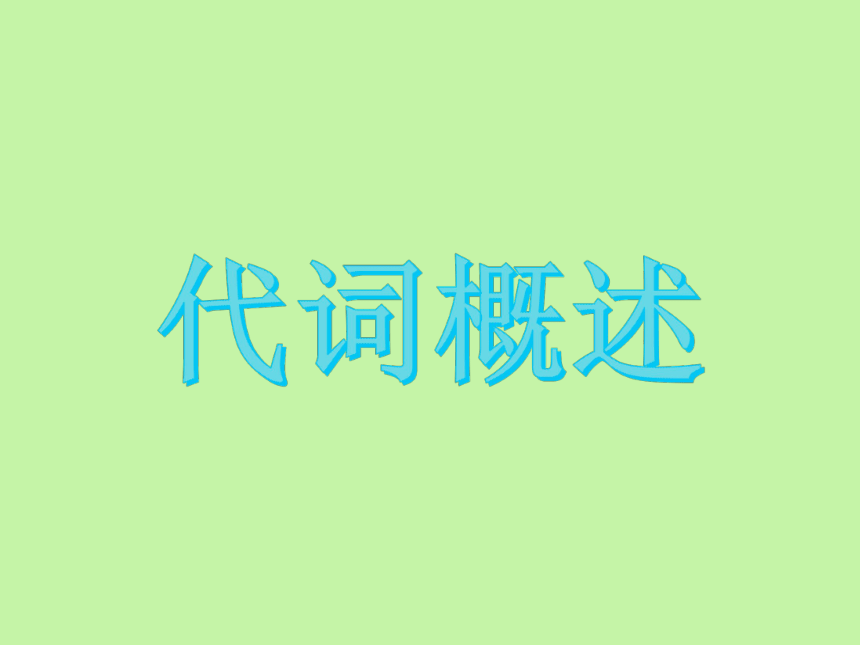
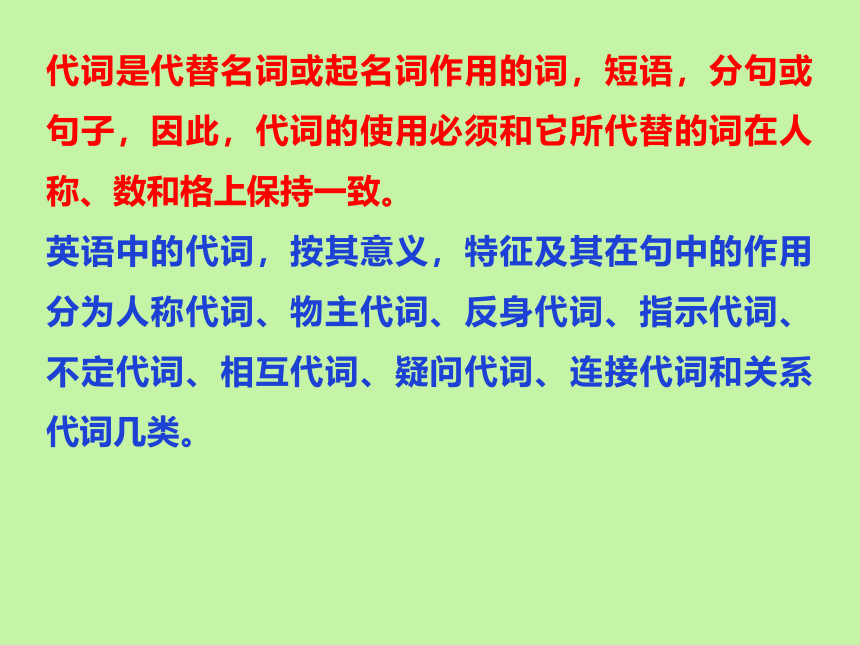
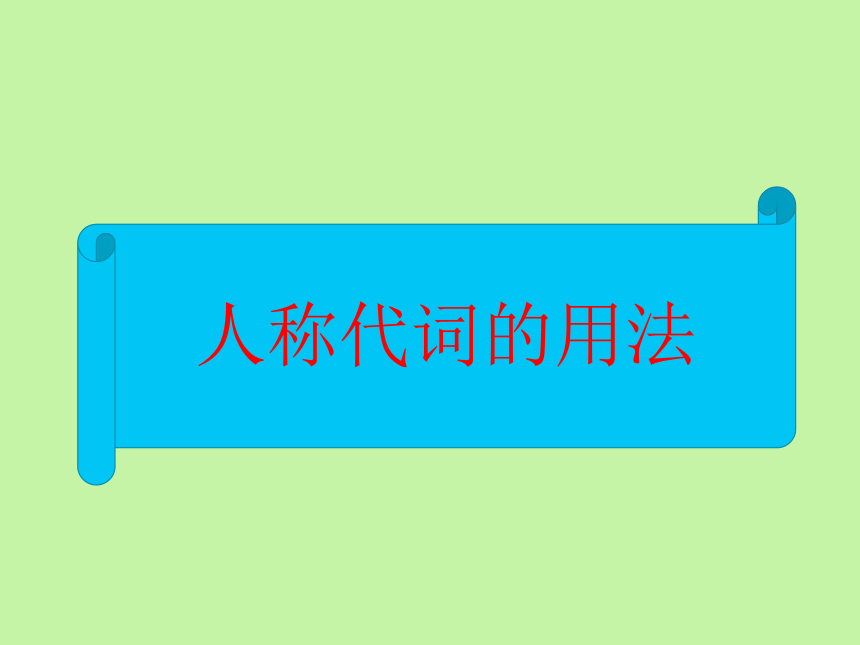
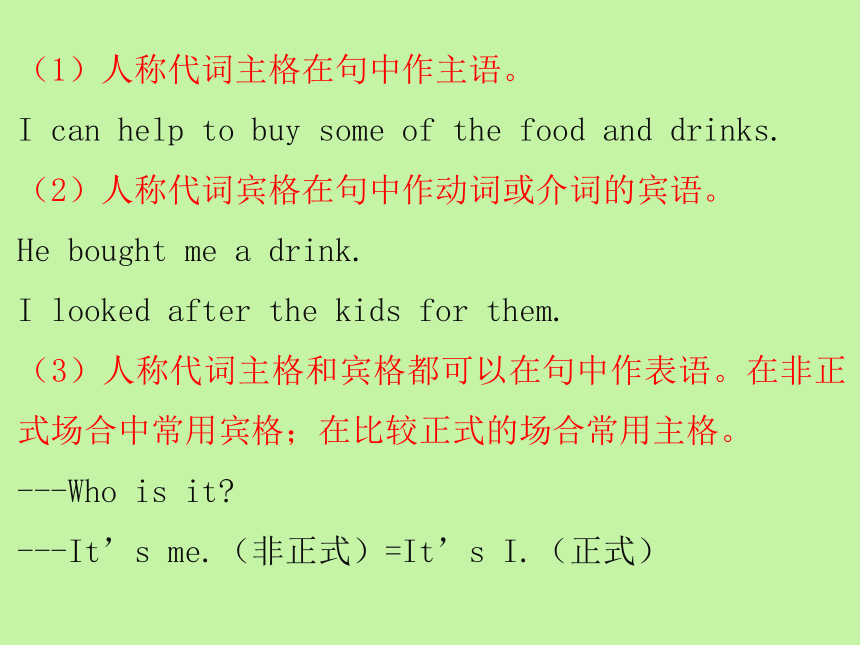
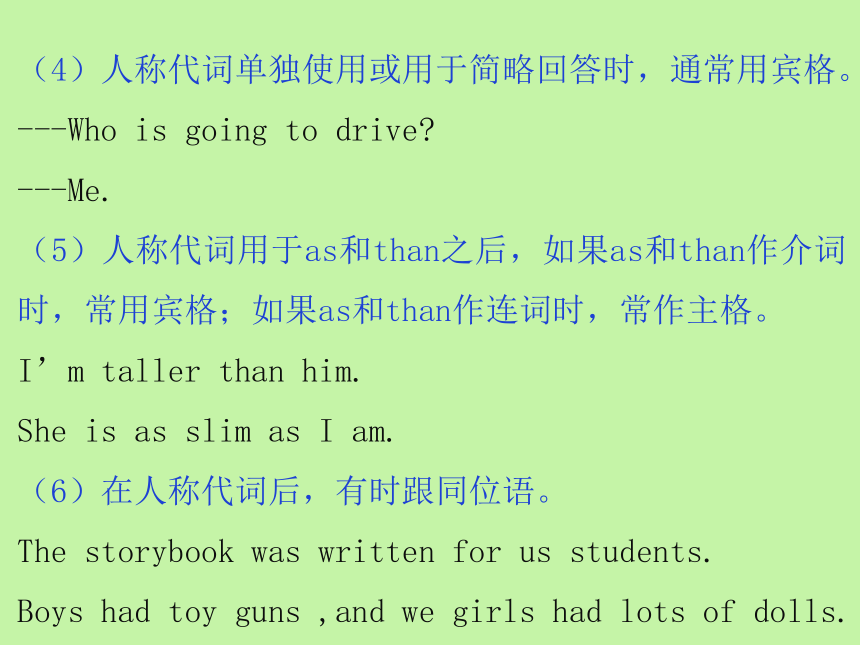
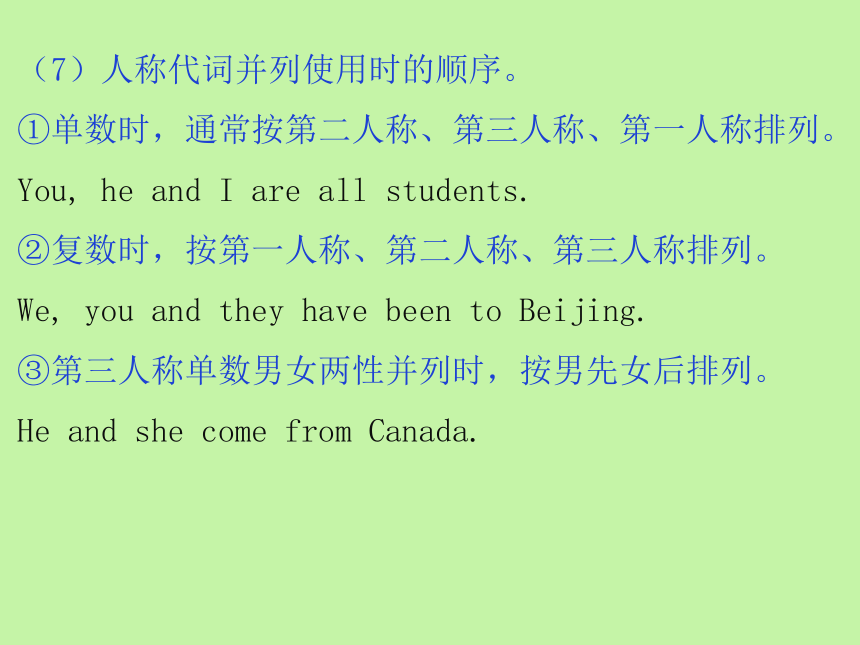
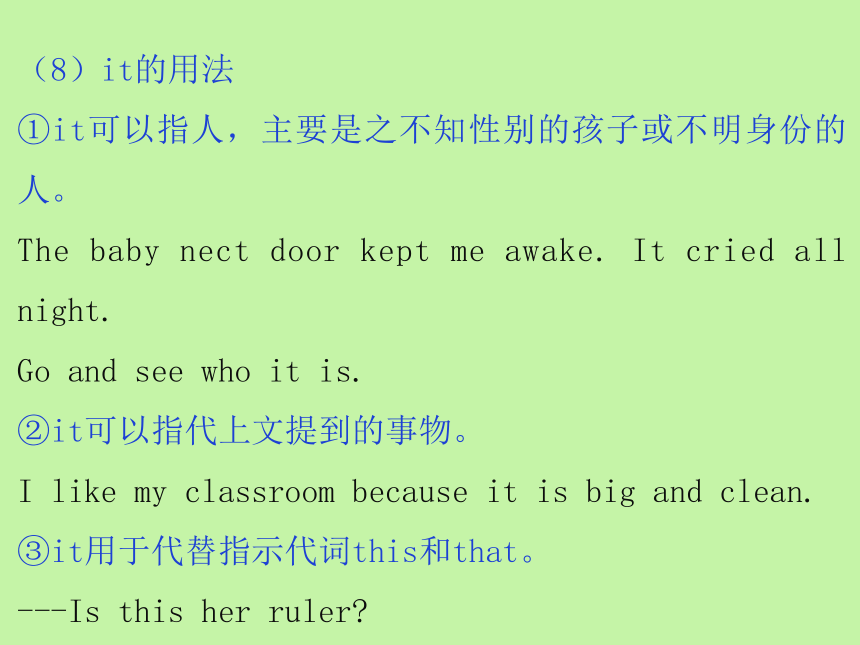
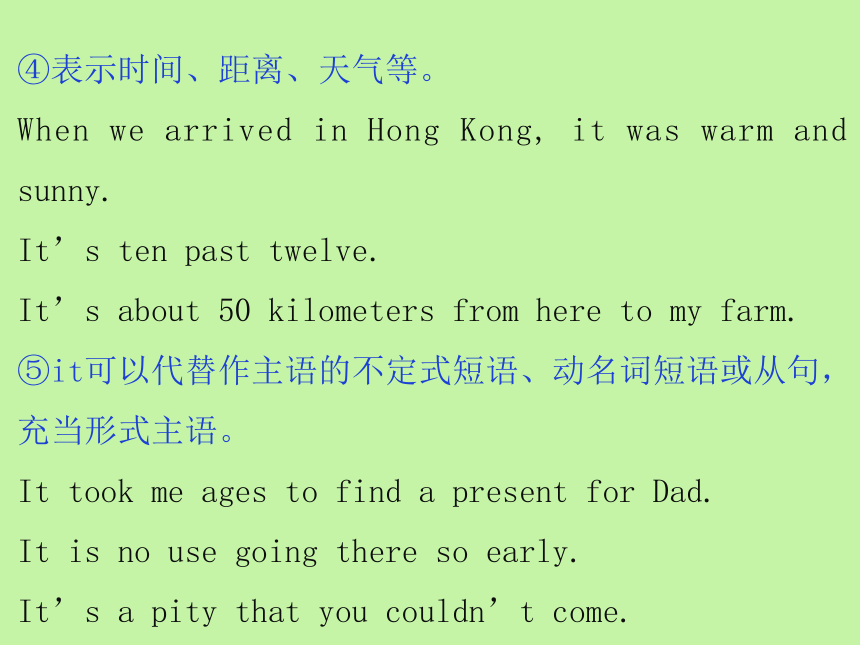

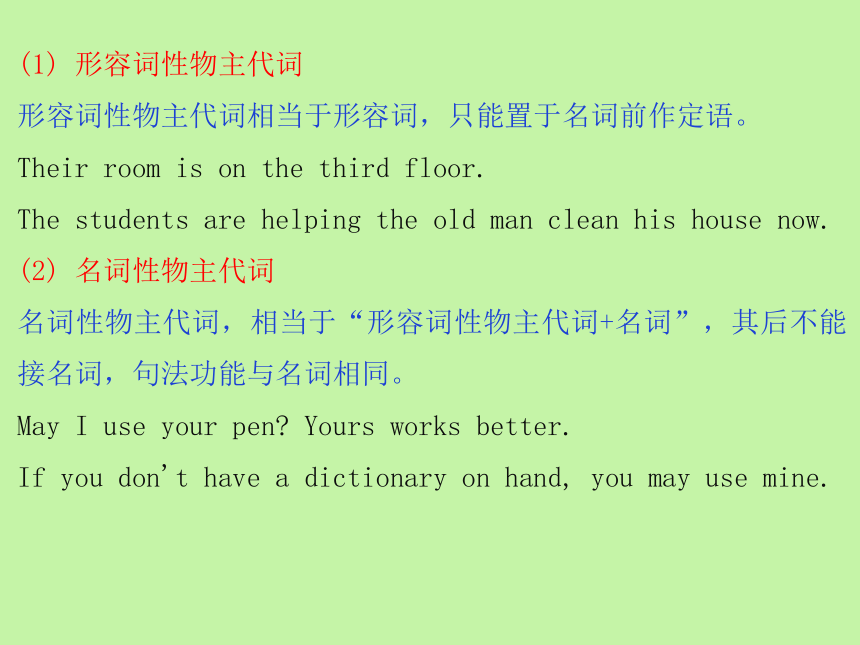
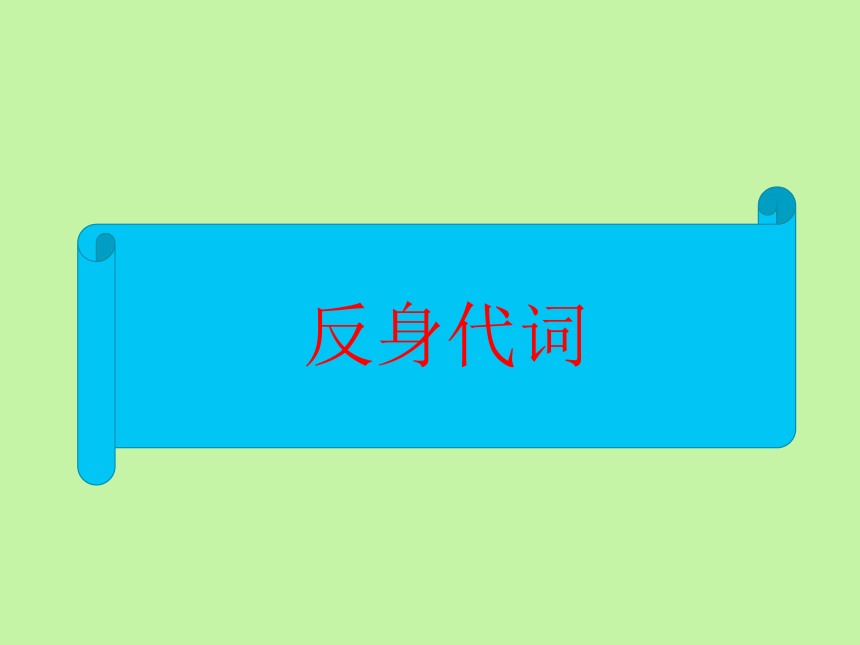
文档简介
(共39张PPT)
代词是代替名词或起名词作用的词,短语,分句或句子,因此,代词的使用必须和它所代替的词在人称、数和格上保持一致。
英语中的代词,按其意义,特征及其在句中的作用分为人称代词、物主代词、反身代词、指示代词、不定代词、相互代词、疑问代词、连接代词和关系代词几类。
人称代词的用法
(1)人称代词主格在句中作主语。
I can help to buy some of the food and drinks.
(2)人称代词宾格在句中作动词或介词的宾语。
He bought me a drink.
I looked after the kids for them.
(3)人称代词主格和宾格都可以在句中作表语。在非正式场合中常用宾格;在比较正式的场合常用主格。
---Who is it
---It’s me.(非正式)=It’s I.(正式)
(4)人称代词单独使用或用于简略回答时,通常用宾格。
---Who is going to drive
---Me.
(5)人称代词用于as和than之后,如果as和than作介词时,常用宾格;如果as和than作连词时,常作主格。
I’m taller than him.
She is as slim as I am.
(6)在人称代词后,有时跟同位语。
The storybook was written for us students.
Boys had toy guns ,and we girls had lots of dolls.
(7)人称代词并列使用时的顺序。
①单数时,通常按第二人称、第三人称、第一人称排列。
You, he and I are all students.
②复数时,按第一人称、第二人称、第三人称排列。
We, you and they have been to Beijing.
③第三人称单数男女两性并列时,按男先女后排列。
He and she come from Canada.
(8)it的用法
①it可以指人,主要是之不知性别的孩子或不明身份的人。
The baby nect door kept me awake. It cried all night.
Go and see who it is.
②it可以指代上文提到的事物。
I like my classroom because it is big and clean.
③it用于代替指示代词this和that。
---Is this her ruler
---Yes, it is. It’s her ruler.
④表示时间、距离、天气等。
When we arrived in Hong Kong, it was warm and sunny.
It’s ten past twelve.
It’s about 50 kilometers from here to my farm.
⑤it可以代替作主语的不定式短语、动名词短语或从句,充当形式主语。
It took me ages to find a present for Dad.
It is no use going there so early.
It’s a pity that you couldn’t come.
物主代词
(1) 形容词性物主代词
形容词性物主代词相当于形容词,只能置于名词前作定语。
Their room is on the third floor.
The students are helping the old man clean his house now.
(2) 名词性物主代词
名词性物主代词,相当于“形容词性物主代词+名词”,其后不能接名词,句法功能与名词相同。
May I use your pen Yours works better.
If you don't have a dictionary on hand, you may use mine.
反身代词
表示动作回执到其执行者本身,用以加强语气,意为我(们)自己,你(们)自己,他/她/它(们)自己的代词称为反身代词。
反身代词作动词的宾语,表示动作的承受者,就是动作的执行者,也可用在介词后作宾语,与句子主语互指。
Boys, don't lose yourselves in playing. It's bad for your eyes to play computer games for long time.
反身代词与某些动词或介词搭配构成固定短语,表示特殊意义。含反身代词的常用的固定搭配有:
enjoy yourself 玩的愉快
help oneself to 随便吃/喝
dress oneself 自己穿衣
come to oneself 恢复知觉
for oneself 亲自
learn by oneself 自学
teach oneself 自学
talk to oneself 自言自语
指示代词
(1) this/ these表示在时间上或空间上较近的人或物。that/ those表示在时间上或空间上较远的人或物。
This is my new pen pal.
In those days the workers had a hard time.
(2) that还可以指上文提到的事物,this指下文中将要提到的事物。
I had a bad cold. That was why I didn't go to school.
Please remember this: No pains, No gains.
(3) 打电话时,常用this指自己,that指对方。
This is Allen. Who's that speaking
Hello, this is Mary. Who's that This is Tom.
(4)为了避免重复,that可指代前面提到的单数可数名词和不可数名词,those可代替复数可数可数名词,其后总有修饰。
In summer in Beijing is cooler than that in Shanghai.
Television sets made in Beijing are just as good as those made in Shanghai.
不定代词
1.some, any
(1) 表示“一些”时,some和any既可以修饰可数名词,也可以修饰不可数名词。一般来说,some常用于肯定句中,而any常用于否定句和疑问句中。
He asked for tea, so I gave him some.
Is there any reason for changing the plan
(2) some用于疑问句时,表建议请求,邀请等,并希望得到对方的肯定回答。
Would you buy me some stamps when you pass the post office
Can I have some coffee with sugar
2. all, both
all和both都意为“都”。all指三者或三者以上的人或物; both则指两个人或物。
They were only two paintings for sale and he bought both.
We should protect the beautiful flowers on both sides of the street.
All of them have now become writers.
All was quiet in the street outside.
Both men and women are not of the same character.
3. one
(1)可以用来代替单数可数名词,表示泛指意义;ones用来代替复数可数名词。
I've been looking for map but I can't find one.
There are twenty old tables in our classroom. Our teacher wants to buy ten new ones.
(2) one, it和that的区别
one可指代单数可数名词,指上文出现过的同一类事物。替代同一类人或事物时,其前面必须有如the, some, all等限定词,同一类人或事物的复数用ones。it可代替单数可数词,指同一个,不能带任何修饰语。that可代替前面提到过的单数可数名词或者不可数名词,他表示同一类而不是同一个,其后面常带有修饰语。
Which jacket would you like, this one or that one
I can't find my hat, I don't know where I put it.
The population of China is larger than that in India.
4. either,neither
(1) either表示“两者中的任何一个”,做主语时,谓语动词常用单数形式,起其后可接of短语。
You can come on Saturday or Sunday. Either is OK for me.
We can't care much for what to eat. Either of the two will do.
(2) neither 表示“两者都不”,做主语时,谓语动词常用单数形式,其后可接of短语。
We have red and yellow T-shirts. Which color do you like
Oh, neither. I think blue will be OK.
Neither of them wants to speak to him about this matter.
5. each,every
(1) each指代或修饰单数可数名词,强调个体,多用于两者或两者以上的场合。作主语时,谓语动词用单数
Each of them knows the whole thing.
There are trees on each side of the road.
We each have a ticket.
(2) every修饰单数可数名词,强调整体,用于三者或三者以上的场合。every修饰名词做主语时,谓语动词用单数。
Every day is a new opportunity.
Every student will take part in the research.
6. none, no one
(1) none意为“三者或三者以上都不”,指代人或物,既可指代复数可数名词,也可指代不可数名词,可与of连用。替代复数可数名词做主语时,谓语动词用单、复数均可。常用来回答以how many/ how much提出的特殊疑问句。
How much money do you have --- None.
I need some paper, but there is none at hand.
(2) no one意为“没有一个人”,常指人,仅用于指代单数可数名词,常用来回答以who提出的特殊疑问句。
Who is absent from class today No one, sir.
No one knows all of it.
7. other, the other, others, the others和another
(1) other意为“另外的”,只能作定语,常与复数可数名词和不可数名词连用。
I suggested a camping holiday, but Jane had other ideas.
Other people may not think that way.
They have no other place to go.
(2) the other意为“两者中的另一个”,常与one连用,构成"one...the other..."结构。
I have two brothers. One is a salesman, and the other is an engineer.
Hold it in this hand, not the other hand.
(3) others泛指"别的人或物",相当于"other+复数可数名词",常构成“some...others...”结构。
Some boys are playing basketball, and others are playing soccer.
Some people like tea, others like coffee and others like milk.
(4) the others特指“其余所有的人或物”,相当于“the other+ 复数可数名词”。
Three of us remain here and all the others go to the next room.
Some students swept the floor, and the others cleaned the windows.
(5) another表示“三者或三者以上中的任何一个”,一般修饰或代替单数可数名词。常用于“another+数词+复数可数名词”结构,相当于“数词+more/other+复数可数名词”,表示在原有的基础上需要更多数量的东西。
Could we see each other at nine o'clock tomorrow morning
Sorry. Let's make it another time.
They need another two hours to finish this work.
8. many, much
many和much都表示“许多,大量”。many只修饰复数可数名词,much是修饰不可数名词。
My cousins have collected stamps for two years, they have many stamps from different countries.
It's a small car,doesn't use much fuel.
9. few, a few, little, a little
I have been to Beijing a few times.
He has written many books, but few of them are good.
Please add a little sugar to the coffee.
There is little news about this movie star in this paper. Where can I get some
10. 复合不定代词
疑问代词
1. who, whom的用法
两者都意为"谁",用来指人,其中who可做主语,宾语和表语,whom只用作宾语。在介词后作宾语只能用whom, 而不能用who。
Who is that man over there He's my uncle.
Who are you writing to
To whom did you speak on the playground
2. whose的用法
whose意为"谁的",既可置于名词前作定语,也可单独使用,作主语和表语。
Whose dictionary is this
They are good at math, but whose is the best
Whose are those flowers
3. which的用法
which意为"哪一个,哪一些",可用来指代人或物在句中作主语,宾语和定语。它与who及what的不同在于which一般有特定的选择范围,而who和what则没有。
Which would you like to choose to live in, Chengdu, Beijing or Shanghai Chengdu, I think.
Which T- shirt do you like better, the red one or the blue one I prefer the red one.
4. what的用法
what意为"什么"可单独使用,也可放在名词前,既可以指代或修饰单数可数名词,也可以指代或修饰复数可数名词。在句中作主语,宾语,表语,定语。
What makes you love your hometown so much
What are your reasons for leaving
相互代词
相互代词表示相互关系的代词。主要有each other和one another, 意为“相互,互相”。each other 主要用于两者之间,one another要用于三者或三者以上。在现代英语中,each other也可以用于三者或三者以上之间。
We often help each other/ one another when we are in trouble.
We began to blame each other/ one another.
He put all his books beside each other/ one another.
代词是代替名词或起名词作用的词,短语,分句或句子,因此,代词的使用必须和它所代替的词在人称、数和格上保持一致。
英语中的代词,按其意义,特征及其在句中的作用分为人称代词、物主代词、反身代词、指示代词、不定代词、相互代词、疑问代词、连接代词和关系代词几类。
人称代词的用法
(1)人称代词主格在句中作主语。
I can help to buy some of the food and drinks.
(2)人称代词宾格在句中作动词或介词的宾语。
He bought me a drink.
I looked after the kids for them.
(3)人称代词主格和宾格都可以在句中作表语。在非正式场合中常用宾格;在比较正式的场合常用主格。
---Who is it
---It’s me.(非正式)=It’s I.(正式)
(4)人称代词单独使用或用于简略回答时,通常用宾格。
---Who is going to drive
---Me.
(5)人称代词用于as和than之后,如果as和than作介词时,常用宾格;如果as和than作连词时,常作主格。
I’m taller than him.
She is as slim as I am.
(6)在人称代词后,有时跟同位语。
The storybook was written for us students.
Boys had toy guns ,and we girls had lots of dolls.
(7)人称代词并列使用时的顺序。
①单数时,通常按第二人称、第三人称、第一人称排列。
You, he and I are all students.
②复数时,按第一人称、第二人称、第三人称排列。
We, you and they have been to Beijing.
③第三人称单数男女两性并列时,按男先女后排列。
He and she come from Canada.
(8)it的用法
①it可以指人,主要是之不知性别的孩子或不明身份的人。
The baby nect door kept me awake. It cried all night.
Go and see who it is.
②it可以指代上文提到的事物。
I like my classroom because it is big and clean.
③it用于代替指示代词this和that。
---Is this her ruler
---Yes, it is. It’s her ruler.
④表示时间、距离、天气等。
When we arrived in Hong Kong, it was warm and sunny.
It’s ten past twelve.
It’s about 50 kilometers from here to my farm.
⑤it可以代替作主语的不定式短语、动名词短语或从句,充当形式主语。
It took me ages to find a present for Dad.
It is no use going there so early.
It’s a pity that you couldn’t come.
物主代词
(1) 形容词性物主代词
形容词性物主代词相当于形容词,只能置于名词前作定语。
Their room is on the third floor.
The students are helping the old man clean his house now.
(2) 名词性物主代词
名词性物主代词,相当于“形容词性物主代词+名词”,其后不能接名词,句法功能与名词相同。
May I use your pen Yours works better.
If you don't have a dictionary on hand, you may use mine.
反身代词
表示动作回执到其执行者本身,用以加强语气,意为我(们)自己,你(们)自己,他/她/它(们)自己的代词称为反身代词。
反身代词作动词的宾语,表示动作的承受者,就是动作的执行者,也可用在介词后作宾语,与句子主语互指。
Boys, don't lose yourselves in playing. It's bad for your eyes to play computer games for long time.
反身代词与某些动词或介词搭配构成固定短语,表示特殊意义。含反身代词的常用的固定搭配有:
enjoy yourself 玩的愉快
help oneself to 随便吃/喝
dress oneself 自己穿衣
come to oneself 恢复知觉
for oneself 亲自
learn by oneself 自学
teach oneself 自学
talk to oneself 自言自语
指示代词
(1) this/ these表示在时间上或空间上较近的人或物。that/ those表示在时间上或空间上较远的人或物。
This is my new pen pal.
In those days the workers had a hard time.
(2) that还可以指上文提到的事物,this指下文中将要提到的事物。
I had a bad cold. That was why I didn't go to school.
Please remember this: No pains, No gains.
(3) 打电话时,常用this指自己,that指对方。
This is Allen. Who's that speaking
Hello, this is Mary. Who's that This is Tom.
(4)为了避免重复,that可指代前面提到的单数可数名词和不可数名词,those可代替复数可数可数名词,其后总有修饰。
In summer in Beijing is cooler than that in Shanghai.
Television sets made in Beijing are just as good as those made in Shanghai.
不定代词
1.some, any
(1) 表示“一些”时,some和any既可以修饰可数名词,也可以修饰不可数名词。一般来说,some常用于肯定句中,而any常用于否定句和疑问句中。
He asked for tea, so I gave him some.
Is there any reason for changing the plan
(2) some用于疑问句时,表建议请求,邀请等,并希望得到对方的肯定回答。
Would you buy me some stamps when you pass the post office
Can I have some coffee with sugar
2. all, both
all和both都意为“都”。all指三者或三者以上的人或物; both则指两个人或物。
They were only two paintings for sale and he bought both.
We should protect the beautiful flowers on both sides of the street.
All of them have now become writers.
All was quiet in the street outside.
Both men and women are not of the same character.
3. one
(1)可以用来代替单数可数名词,表示泛指意义;ones用来代替复数可数名词。
I've been looking for map but I can't find one.
There are twenty old tables in our classroom. Our teacher wants to buy ten new ones.
(2) one, it和that的区别
one可指代单数可数名词,指上文出现过的同一类事物。替代同一类人或事物时,其前面必须有如the, some, all等限定词,同一类人或事物的复数用ones。it可代替单数可数词,指同一个,不能带任何修饰语。that可代替前面提到过的单数可数名词或者不可数名词,他表示同一类而不是同一个,其后面常带有修饰语。
Which jacket would you like, this one or that one
I can't find my hat, I don't know where I put it.
The population of China is larger than that in India.
4. either,neither
(1) either表示“两者中的任何一个”,做主语时,谓语动词常用单数形式,起其后可接of短语。
You can come on Saturday or Sunday. Either is OK for me.
We can't care much for what to eat. Either of the two will do.
(2) neither 表示“两者都不”,做主语时,谓语动词常用单数形式,其后可接of短语。
We have red and yellow T-shirts. Which color do you like
Oh, neither. I think blue will be OK.
Neither of them wants to speak to him about this matter.
5. each,every
(1) each指代或修饰单数可数名词,强调个体,多用于两者或两者以上的场合。作主语时,谓语动词用单数
Each of them knows the whole thing.
There are trees on each side of the road.
We each have a ticket.
(2) every修饰单数可数名词,强调整体,用于三者或三者以上的场合。every修饰名词做主语时,谓语动词用单数。
Every day is a new opportunity.
Every student will take part in the research.
6. none, no one
(1) none意为“三者或三者以上都不”,指代人或物,既可指代复数可数名词,也可指代不可数名词,可与of连用。替代复数可数名词做主语时,谓语动词用单、复数均可。常用来回答以how many/ how much提出的特殊疑问句。
How much money do you have --- None.
I need some paper, but there is none at hand.
(2) no one意为“没有一个人”,常指人,仅用于指代单数可数名词,常用来回答以who提出的特殊疑问句。
Who is absent from class today No one, sir.
No one knows all of it.
7. other, the other, others, the others和another
(1) other意为“另外的”,只能作定语,常与复数可数名词和不可数名词连用。
I suggested a camping holiday, but Jane had other ideas.
Other people may not think that way.
They have no other place to go.
(2) the other意为“两者中的另一个”,常与one连用,构成"one...the other..."结构。
I have two brothers. One is a salesman, and the other is an engineer.
Hold it in this hand, not the other hand.
(3) others泛指"别的人或物",相当于"other+复数可数名词",常构成“some...others...”结构。
Some boys are playing basketball, and others are playing soccer.
Some people like tea, others like coffee and others like milk.
(4) the others特指“其余所有的人或物”,相当于“the other+ 复数可数名词”。
Three of us remain here and all the others go to the next room.
Some students swept the floor, and the others cleaned the windows.
(5) another表示“三者或三者以上中的任何一个”,一般修饰或代替单数可数名词。常用于“another+数词+复数可数名词”结构,相当于“数词+more/other+复数可数名词”,表示在原有的基础上需要更多数量的东西。
Could we see each other at nine o'clock tomorrow morning
Sorry. Let's make it another time.
They need another two hours to finish this work.
8. many, much
many和much都表示“许多,大量”。many只修饰复数可数名词,much是修饰不可数名词。
My cousins have collected stamps for two years, they have many stamps from different countries.
It's a small car,doesn't use much fuel.
9. few, a few, little, a little
I have been to Beijing a few times.
He has written many books, but few of them are good.
Please add a little sugar to the coffee.
There is little news about this movie star in this paper. Where can I get some
10. 复合不定代词
疑问代词
1. who, whom的用法
两者都意为"谁",用来指人,其中who可做主语,宾语和表语,whom只用作宾语。在介词后作宾语只能用whom, 而不能用who。
Who is that man over there He's my uncle.
Who are you writing to
To whom did you speak on the playground
2. whose的用法
whose意为"谁的",既可置于名词前作定语,也可单独使用,作主语和表语。
Whose dictionary is this
They are good at math, but whose is the best
Whose are those flowers
3. which的用法
which意为"哪一个,哪一些",可用来指代人或物在句中作主语,宾语和定语。它与who及what的不同在于which一般有特定的选择范围,而who和what则没有。
Which would you like to choose to live in, Chengdu, Beijing or Shanghai Chengdu, I think.
Which T- shirt do you like better, the red one or the blue one I prefer the red one.
4. what的用法
what意为"什么"可单独使用,也可放在名词前,既可以指代或修饰单数可数名词,也可以指代或修饰复数可数名词。在句中作主语,宾语,表语,定语。
What makes you love your hometown so much
What are your reasons for leaving
相互代词
相互代词表示相互关系的代词。主要有each other和one another, 意为“相互,互相”。each other 主要用于两者之间,one another要用于三者或三者以上。在现代英语中,each other也可以用于三者或三者以上之间。
We often help each other/ one another when we are in trouble.
We began to blame each other/ one another.
He put all his books beside each other/ one another.
同课章节目录
- 词法
- 名词
- 动词和动词短语
- 动词语态
- 动词时态
- 助动词和情态动词
- 非谓语动词
- 冠词
- 代词
- 数词和量词
- 形容词副词及其比较等级
- 介词和介词短语
- 连词和感叹词
- 构词法
- 相似、相近词比较
- 句法
- 陈述句
- 一般疑问句和否定疑问句
- 特殊疑问句及选择疑问句
- 反意疑问句
- 存在句(There be句型)
- 宾语从句
- 定语从句
- 状语从句
- 主谓一致问题
- 简单句
- 并列句
- 复合句
- 主谓一致
- 主、表语从句
- 名词性从句
- 直接引语和间接引语
- 虚拟语气
- 感叹句
- 强调句
- 倒装句
- 祈使句
- 句子的成分
- 句子的分类
- 题型专区
- 单项选择部分
- 易错题
- 完形填空
- 阅读理解
- 词汇练习
- 听说训练
- 句型转换
- 补全对话
- 短文改错
- 翻译
- 书面表达
- 任务型阅读
- 语法填空
- 其他资料
